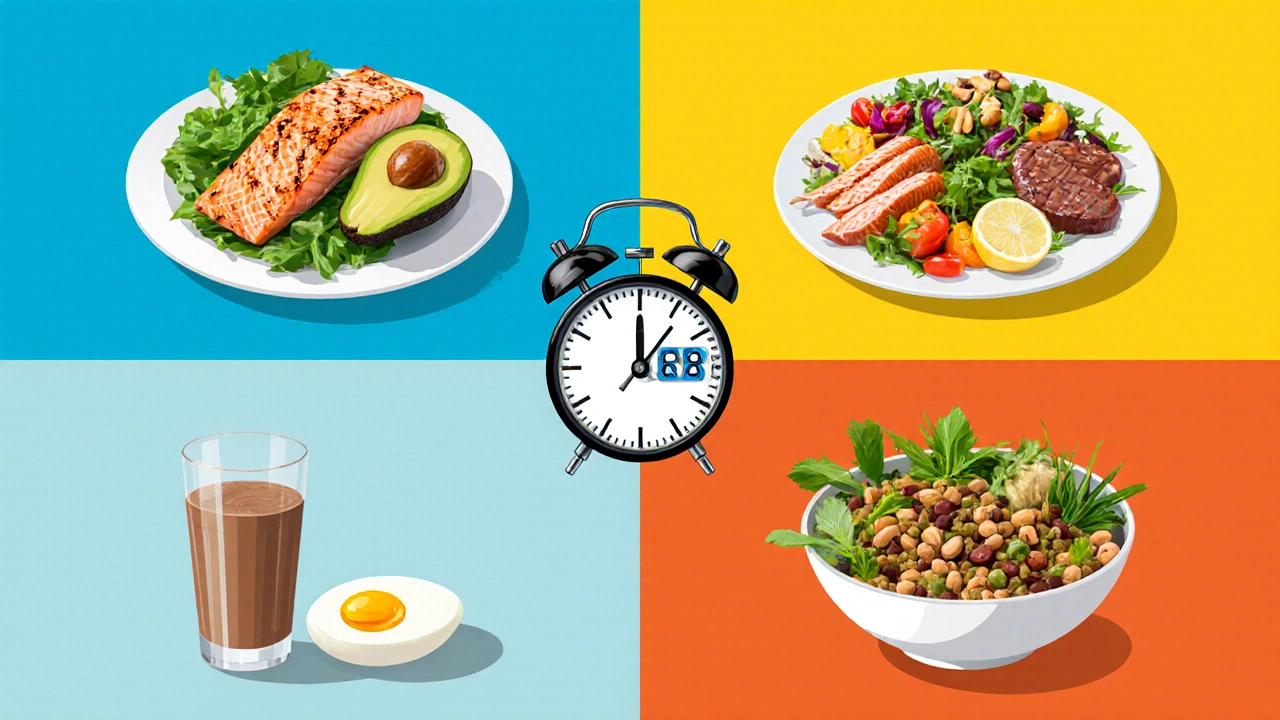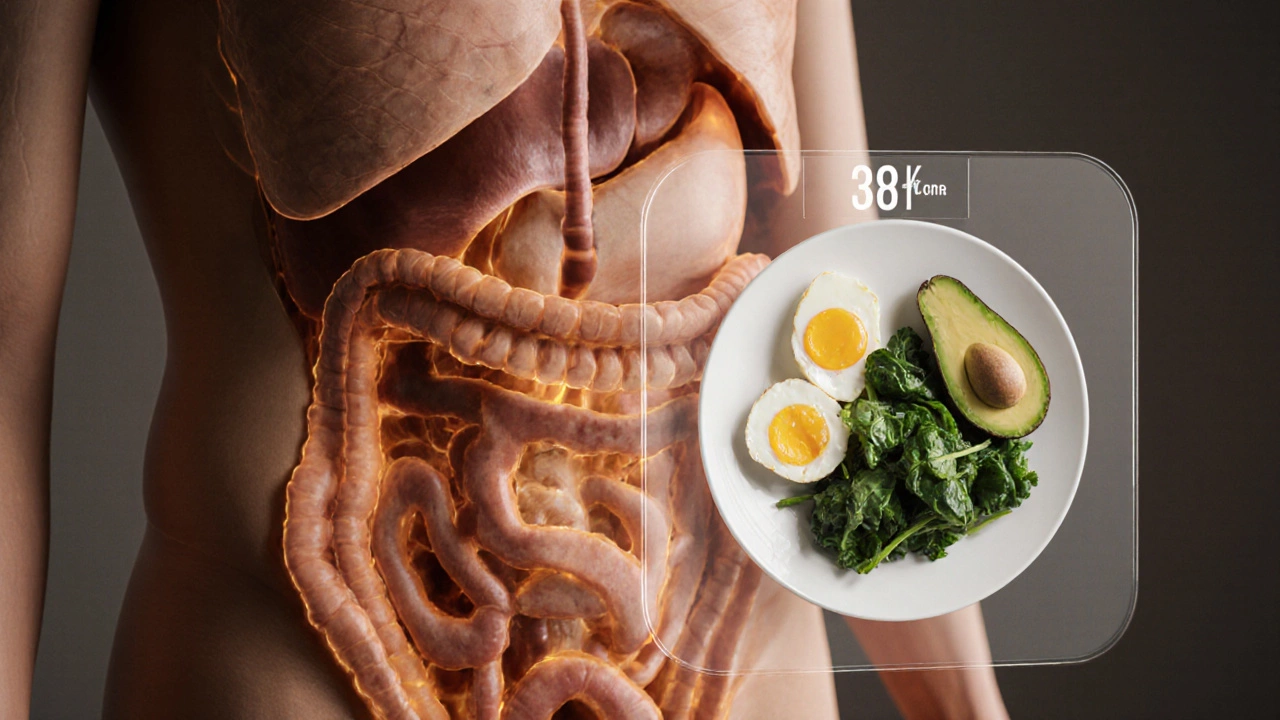Belly Fat Diet Matchmaker
Select what matters most to you. Our tool will recommend the best belly fat loss diet for your lifestyle based on scientific evidence.
Your Recommended Diet
Why This Diet Is Right For You
Expected Waist Reduction
Sample Meal Plan
Quick Takeaways
- Calorie deficit is the non‑negotiable starter for any belly‑fat loss plan.
- Low‑carb, Mediterranean, intermittent fasting, high‑protein, and plant‑based diets all rank in the top five for cutting waistline inches.
- Pick a diet that fits your lifestyle, not just the science - consistency beats perfection.
- Combine your chosen diet with 150‑180 minutes of moderate activity each week for optimal results.
- Use the comparison table below to match diet features with your personal priorities.
Why belly fat is stubborn and how diet changes the game
Visceral fat sits deep around your organs and responds best to overall energy balance. When you consistently eat fewer calories than you burn, the body pulls from its fat stores - including the belly. But the type of calories matters. High‑glycemic carbs spike insulin, which can lock fat in place, while protein and healthy fats keep you fuller longer and support muscle preservation.
In short, the best diet for belly fat bubbles down to two pillars:
- A sustainable calorie deficit.
- Macronutrient choices that keep insulin stable and hunger at bay.
Top five evidence‑backed diets
Below are the five diets that consistently show the fastest waist‑reduction numbers in peer‑reviewed studies from 2020‑2024.
Low‑Carb Diet is a nutrition approach that limits daily carbohydrates to 20‑100g, emphasizing proteins, non‑starchy vegetables, and healthy fats. By curbing carbs, insulin levels drop, encouraging the body to burn stored fat for fuel.
Mediterranean Diet is a heart‑healthy eating pattern that centers on olive oil, nuts, fish, whole grains, and plenty of fruit and veg. Its moderate carb load (about 40‑45% of calories) combined with monounsaturated fats makes it gentle on insulin while still providing a calorie deficit when portion‑controlled.
Intermittent Fasting (IF) is a timing strategy where you restrict eating to a set window-commonly 16hours fast, 8hours feed (16:8). IF doesn’t dictate what you eat, just when, which often results in an automatic reduction of daily calories.
High‑Protein Diet is a regimen that pushes protein intake to 25‑35% of total calories (roughly 1.2‑1.6g perkg body weight). Protein boosts satiety, preserves lean muscle during weight loss, and has a higher thermic effect than carbs or fat.
Plant‑Based Diet is an eating plan that prioritises vegetables, legumes, fruits, nuts, and whole grains while minimizing animal products. When calibrated for a calorie deficit, it delivers fiber‑rich meals that keep insulin smooth and belly fat at bay.

How the diets stack up
| Diet | Typical Carb % | Protein % | Fat % | Ease of Daily Planning | Typical 8‑Week Waist Reduction* (in cm) |
|---|---|---|---|---|---|
| Low‑Carb | 5‑15 | 20‑30 | 55‑70 | Medium - needs carb counting | 6‑9 |
| Mediterranean | 40‑45 | 15‑20 | 35‑40 | High - flexible food choices | 4‑7 |
| Intermittent Fasting (16:8) | Varies with food choice | Varies | Varies | High - simply skip meals | 5‑8 |
| High‑Protein | 30‑35 | 25‑35 | 30‑40 | Medium - need protein‑rich foods | 5‑7 |
| Plant‑Based | 45‑55 | 15‑20 | 30‑35 | High - plenty of recipes online | 3‑6 |
*Results are averages from randomized controlled trials with participants following the diet for eight weeks and maintaining a 500‑kcal daily deficit.
Sample 1‑Week Meal Plan (Low‑Carb Focus)
- Monday: Scrambled eggs with spinach, avocado; grilled salmon with asparagus.
- Tuesday: Greek yogurt (unsweetened) mixed with walnuts; turkey lettuce wraps with cheese and olives.
- Wednesday: Protein shake (whey) + half a banana; stir‑fried beef with broccoli and bell peppers.
- Thursday: Cottage cheese with cucumber; baked chicken thigh with cauliflower mash.
- Friday: Omelette with mushrooms and feta; shrimp salad with mixed greens and olive oil.
- Saturday: Chia seed pudding (coconut milk) topped with berries; pork chops with sautéed zucchini.
- Sunday: Smoked salmon roll‑ups with cream cheese; roasted lamb with rosemary and side salad.
Adjust portion sizes so total daily calories sit about 200‑400kcal below maintenance - that’s the sweet spot for steady belly‑fat loss without muscle loss.

Tips to make the diet stick
- Prep in batches. Cook protein (chicken, beef, legumes) in large trays on Sunday; store in the fridge for quick assembly.
- Use a visual cue. Color‑code your plate: half veggies, a quarter protein, a quarter healthy fat.
- Stay hydrated. Aim for 2.5‑3L of water daily; a glass before meals often curbs overeating.
- Track quickly. Apps that let you snap a photo and auto‑log carbs save time and keep the deficit realistic.
- Allow a cheat. One “flex” meal per week prevents binge‑thinking and keeps hormones balanced.
Common pitfalls and how to dodge them
- Over‑estimating portion size. Even low‑carb foods have calories - weigh meat or use measuring cups.
- Neglecting fiber. Too few veggies can cause constipation and cravings; aim for 25‑30g fiber daily.
- Skipping strength training. Muscle loss slows metabolism; two 30‑minute sessions per week preserve lean tissue.
- Relying on “diet” labels alone. A Mediterranean‑style low‑carb meal can be more sustainable than a strict keto plan you can’t stick to.
Frequently Asked Questions
Can I combine two of these diets?
Yes. Many people pair intermittent fasting with a low‑carb or Mediterranean pattern, gaining the calorie‑control of IF plus the macronutrient benefits of the chosen diet. Just keep the overall deficit under 500‑kcal per day.
How fast will I see my waist shrink?
With a consistent 500‑kcal deficit, most folks lose 0.5‑1kg per week, translating to 1‑2cm off the waist after the first three weeks. Results vary based on genetics, stress, and sleep.
Do I need to count calories with intermittent fasting?
You don’t have to count every calorie, but a quick glance at portion sizes helps. If you eat the same meals as on non‑fasting days, you’ll likely stay in a deficit without tracking.
Is a low‑carb diet safe for long‑term use?
For healthy adults, a well‑formulated low‑carb plan is safe for months or years, provided you include enough fibre, micronutrients, and occasional carb re‑feeds if you feel sluggish.
What role does stress play in belly‑fat loss?
High cortisol from chronic stress can promote fat storage around the abdomen. Managing stress through sleep, meditation, or light activity amplifies any diet’s effectiveness.





